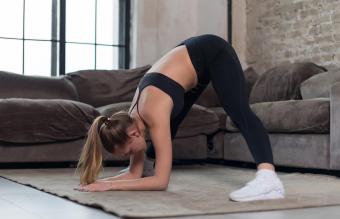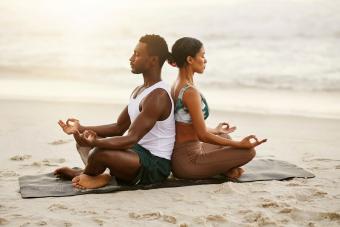
Dynamic stretching of the hamstrings before a workout helps prepare your legs to work, and static stretching after your workout helps you avoid soreness and recover faster. Exercise certainly has tremendous value, but it also stresses your muscles which stretching can help relieve.
Examples of Stretches
As when doing any exercises or stretches, it is important to listen to your body for cues of strain or overdoing it. The purpose of hamstring stretches is to avoid injury, not cause it. Move slowly, avoiding any jerking movements which can cause muscle strain.
Touch Your Toes
The nice thing about touching your toes is you have a means to check your progress after adding hamstring stretches to your exercise routine. There are several variations, so that you can use this exercise no matter how flexible or inflexible your hamstrings are. Note that if you typically get dizzy by allowing your head to drop below your heart, or if you are of an advanced age, try this stretch from a seated position instead of standing.
- First, try to bend over and touch your toes, without rounding your back. If this is uncomfortable, try allowing a little bend to your knees.
- Hold the stretch for at least five breaths.
- If you cannot touch your toes, try reaching for a yoga brick placed in front of your feet so that you can still experience the stretch.
- If touching your toes is no problem, try increasing the challenge by crossing your left leg over your right before you attempt to touch your toes. Advanced exercisers can do this stretch alternating on one leg, followed by the other leg.
Push Against a Wall
This stretch is a good stretch to do after a lower body cardio workout such as walking or jogging. You can do this exercise almost anyplace, making it both beneficial and convenient.
- Lean forward until you are touching a wall or other stationary object at an angle with your extended arms.
- Bend your left knee and extend your right leg back so that there is an unbroken line from your head to your foot.
- Push against the wall with your arms.
- You will feel a comfortable stretch that will extend from your calves to your hamstrings.
- Hold the stretch, then repeat with the other leg.
Supine Hamstring Stretch
This stretch, like the toe touch, is a good way for you to loosen tight hamstrings.
- Begin by lying on your back on an exercise mat.
- Bend both knees, placing both feet on the floor, hip distance apart.
- Raise your left leg straight up into the air, clasping both hands behind the back of your thigh as you gently pull forward.
- If you cannot keep your leg straight, don't worry. Stretch your leg as far as you are able.
- As you increase in flexibility, you will be able to move your leg closer to your upper body.
Dynamic Hamstring Curls
This stretch is especially good before a workout as it helps prepare these muscles to work. If you have balance issues, do this stretch while holding onto a chair in front of you. These stretches are good for sore hamstrings and the dynamic nature of these stretches can make them doable despite pulled hamstrings.
- Stand upright, leaning your weight slightly to your right foot as you bend your left knee to draw the left lower leg behind you.
- Return your left foot to the ground as you shift your weight to that foot as you bend your right knee to draw the lower right leg behind you.
- This curl is a dynamic stretch, so repeat from side to side quickly and without pausing.
Lateral Lunges
Lateral lunges can be done both dynamic or static, depending on whether you're warming up or cooling down. Lateral lunges are similar to traditional lunges, but with one leg extended out to the side.

- Extend your right leg to the side, shifting the weight in your hips behind you and to the right.
- Don't round out your back and don't allow your chest to drop forward. Lean your upper body to the right slightly to deepen the stretch.
- Your right leg remains straight while your left leg is bent at the knee.
- For more challenge, reach your right arm toward the left, keeping your arm behind your face.
- To make this stretch easier, rest your left arm on your left thigh as you stretch.
Seated Hamstring Stretch
This stretch can be done seated. Since it's a static stretch, it is most appropriate following exercise.
- While sitting in a chair, extend your legs straight ahead of you with your heels on the ground and toes pointed upward.
- Exhale and hinge at the hips while keeping a straight back
- Reach your hands toward your toes. If you can't reach your toes, reach for your shins.
- Hold the stretch for up to 30 seconds.
Hamstring Anatomy
Your hamstrings are actually three different muscles collectively called by this term. They include the biceps femoris, semitendinosus and semimembranosus muscles, located on the back of your thighs. Their primary functions are flexing of your knees and extension of your hips. They can be easy to strain without proper exercise and hamstring stretches.
Benefits of Hamstring Stretches
There are several benefits from doing stretches targeting hamstrings. The primary benefits focus on improving your overall athletic performance. Stretching improves the flexibility of your hamstrings, helping you prevent injury during your workouts. These stretches can also help you function in daily life as tight hamstrings are a common cause of lower back pain. Incorporate hamstring stretches into your exercise routine and you'll soon feel more stable throughout your entire body.







